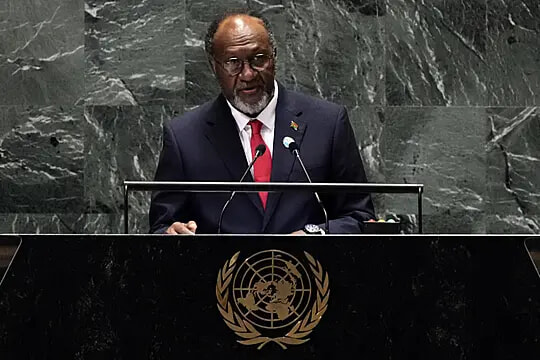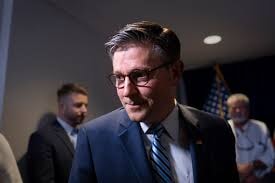
New York is Building the U.S.'s First Major Nuclear Power Plant in a Generation
This is big.
Published June 30, 2025
Advertisement
Advertisement
1. A New Era for Nuclear Power in New York

Governor Kathy Hochul announced an ambitious plan on June 23, 2025, to construct New York’s first new nuclear power plant in over three decades, marking a dramatic shift in the state’s energy policy.Standing at the Niagara County Power Project, Hochul emphasized that this initiative would ensure a stable, affordable, and clean power grid as the state retires aging fossil fuel plants and confronts surging electricity demands.The planned advanced, zero-emission reactor—capable of generating at least one gigawatt—aims to power up to a million homes and will boost the state’s nuclear capacity to about 4.3 gigawatts.Hochul described the project as central to New York’s “energy independence,” calling on the New York Power Authority (NYPA) to immediately begin exploring technologies, business models, and suitable upstate locations for the facility.This bold move comes just four years after the controversial shutdown of the Indian Point nuclear plant, which once provided a quarter of New York City’s electricity but was closed due to environmental concerns.The closure led to increased reliance on fossil fuels and a subsequent rise in greenhouse gas emissions, prompting widespread debate about the state’s clean energy future.As energy needs grow—driven by electrification, new industry, and data centers—Hochul’s plan signals a critical pivot back to nuclear energy as a solution to supply constraints and the risk of rolling blackouts.While Hochul assured that “this is not your grandparents’ nuclear reactor,” she also acknowledged the concerns around nuclear safety, cost, and waste disposal.The governor’s administration promises to prioritize automatic safety systems and rigorous environmental standards in designing the new facility, emphasizing transparency and public engagement throughout the process.With this announcement, New York positions itself at the forefront of America’s nuclear renaissance, joining a handful of states exploring new reactors amid a nationwide push for reliable, clean energy.
Advertisement
2. Policy Shifts and National Context

Hochul’s nuclear push is unfolding against a backdrop of significant national and industry changes, including shifting federal priorities and a reevaluation of renewable energy strategies.The Biden and Trump administrations have both signaled increased support for advanced nuclear technologies, with Trump recently signing executive orders aimed at streamlining regulatory approval and accelerating new nuclear projects.The U.S. Department of Energy reports that 54 nuclear plants currently operate nationwide, providing nearly 20% of America’s electricity, though this share has fallen from a peak of 23% a decade ago.Recent years have seen mixed fortunes for nuclear power: Georgia Power’s Vogtle project brought online the country’s first new reactors in a generation, but was plagued by billions in cost overruns and years of delays.Private sector interest is surging, fueled by tech giants like Microsoft, Amazon, and Google, which have signed long-term deals to source nuclear energy for data centers and AI computing facilities.New York’s advanced reactor would be the first major plant built since 1989, when Nine Mile Point Unit 2 opened, and stands out as a rare commitment to large-scale nuclear amid a national debate over energy costs, safety, and carbon emissions.Hochul’s plan also seeks to harness public-private partnerships, with the state pledging to purchase power from the new facility, while seeking investment from private entities and potentially federal funding.The move is supported by the state’s powerful building trades and labor unions, which highlight the promise of thousands of construction and permanent jobs, as well as the business community eager for stable power prices.While Hochul’s vision is ambitious, she faces a cautious and sometimes skeptical public, many of whom remember the challenges and controversies of nuclear power’s past.Opponents, including environmental groups and some Democrats, warn that nuclear is expensive, risky, and a potential distraction from faster, cheaper renewable alternatives.Nevertheless, New York’s pivot marks a potential turning point, setting the stage for renewed debate over how best to power the nation’s clean energy future.
Advertisement
3. The Indian Point Closure and Its Ripple Effects

The context for Hochul’s announcement is rooted in the aftermath of the 2021 closure of the Indian Point Energy Center, a decision that continues to reverberate across the state’s energy landscape.Located just 25 miles north of Manhattan along the Hudson River, Indian Point had for decades provided up to a quarter of New York City’s electricity—almost entirely carbon-free.Its closure, driven by longstanding fears about contamination, security risks, and environmental impact, forced New York to replace lost capacity with fossil fuel plants, resulting in increased emissions and higher energy costs.Hochul and many policymakers now characterize the shutdown as “short-sighted,” pointing to the state’s struggle to keep pace with rising demand and its ambitious climate targets.As fossil fuel generators are retired and renewable projects face delays, the reliability of the grid has come under threat, raising the specter of rolling blackouts and energy insecurity.In public remarks, Hochul lamented the absence of an alternative plan when Indian Point was shuttered, noting that “overnight, without an alternative, we’ve had to burn more fuel.”This shortfall has fueled renewed calls for an “all-of-the-above” energy strategy, combining renewables with nuclear to meet the state’s stringent Climate Leadership and Community Protection Act (CLCPA) mandates.That law, signed in 2019, commits New York to sourcing 70% of electricity from renewables by 2030 and achieving net-zero carbon emissions in the energy sector by 2040.Despite these goals, Hochul has conceded that the state may fall behind schedule, stressing that grid stability and affordability must remain top priorities.The governor’s new plan thus represents not just a return to nuclear power, but a tacit admission that renewables alone may not be sufficient for the challenges ahead.As debates continue over site selection, financing, and regulatory oversight, the legacy of Indian Point looms large—shaping both the aspirations and anxieties of New York’s energy transition.
Advertisement
4. The Path to a Clean and Reliable Grid

New York’s nuclear initiative is presented as a cornerstone of a broader strategy to build a reliable, affordable, and carbon-free energy grid for the 21st century.State leaders argue that advanced nuclear reactors offer stable “baseload” power—running all day, every day—complementing intermittent sources like wind and solar.Governor Hochul has underscored the urgency of expanding capacity, warning that failure to do so could result in periodic blackouts and threaten New York’s economic competitiveness.The plan calls for NYPA to develop a one-gigawatt reactor in upstate New York, with the goal of creating 1,600 construction jobs and 1,200 permanent positions once operational.Supporters point to advanced safety features, automated containment systems, and rigorous environmental standards as distinguishing features of next-generation nuclear designs.The new facility is intended not only to address supply gaps left by retired plants but also to support economic growth, especially as the state attracts manufacturers and tech firms with large, predictable energy needs.NYPA, in coordination with the Department of Public Service and New York State Energy Research and Development Authority, will evaluate technologies, assess candidate sites, and identify key public and private partners.Public safety, environmental impact, skilled labor availability, and community support are among the criteria for site selection, as the state seeks to balance urgency with caution.The plan also dovetails with ongoing support for nuclear expansion at existing sites, such as Nine Mile Point, and the possibility of collaborating with neighboring states and Canadian provinces to build robust supply chains.In this vision, nuclear power is not a competitor but a partner to renewables—helping to meet climate goals, protect the grid, and stimulate regional economies.As implementation begins, stakeholders from labor unions to business leaders and public officials are lining up behind the plan, framing it as essential to New York’s clean energy leadership.
Advertisement
5. Economic, Labor, and Industrial Implications

The economic implications of New York’s nuclear pivot are far-reaching, promising job creation, industrial growth, and new opportunities for public-private collaboration.With the state targeting a gigawatt-scale reactor, the construction phase alone is expected to create more than 1,600 jobs, while plant operations will sustain 1,200 permanent positions.Labor unions have enthusiastically endorsed the project, hailing it as a source of “good-paying, family-sustaining, union careers” that will boost local economies and expand the middle class.Manufacturers and tech industry leaders are equally supportive, citing the critical importance of reliable, affordable energy for attracting investment and maintaining global competitiveness.Major companies, including semiconductor manufacturers and data centers, are already flocking to upstate New York, drawn by the promise of stable power prices and clean energy.The plan’s supporters argue that advanced nuclear is uniquely positioned to provide “dispatchable” zero-emission power, meeting spikes in demand that renewables alone can’t always cover.The NYPA is expected to seek partnerships with private investors and federal agencies, spreading costs and risks while leveraging expertise from across the energy sector.State and regional economic development organizations are also promoting the initiative as a magnet for high-tech industries, innovation hubs, and advanced manufacturing.By embracing nuclear, New York hopes to establish itself as a “tech center” on par with Silicon Valley, capitalizing on its proximity to research institutions and established infrastructure.Supporters stress that a diverse, resilient energy mix is essential not only for environmental goals but for sustaining jobs and growth in a rapidly changing global economy.As planning advances, officials promise a transparent, inclusive process, aiming to ensure that the benefits of the project are broadly shared across communities.
Advertisement
6. The Political Debate and Environmental Concerns

Despite broad institutional support, the new nuclear plan faces vocal opposition from environmental groups and some progressive lawmakers, who warn of costs, risks, and opportunity costs.Critics argue that nuclear power remains “dangerous, dirty, and wildly expensive,” diverting resources from proven, scalable renewable options like wind and solar.Groups such as Food & Water Watch and the Public Power NY Coalition caution that focusing on nuclear may delay urgently needed progress toward truly clean, affordable energy.Environmentalists also raise alarms about the potential rollback of regulatory safeguards under accelerated federal approval processes, fearing erosion of health and safety standards.Safety concerns—especially around radioactive waste, plant security, and the risk of accidents—continue to fuel public anxiety, particularly in communities near proposed sites.Cost overruns, such as those experienced in Georgia’s Plant Vogtle project, are frequently cited as cautionary tales, highlighting the financial uncertainties of nuclear construction.Nonetheless, state officials insist that new technologies offer significant improvements over legacy reactors, with automated safety systems and stricter environmental protections.Governor Hochul promises “no cost escalation” for ratepayers, pledging transparency, oversight, and community engagement at every step.Proponents counter that nuclear’s carbon-free credentials, reliability, and small land footprint make it a vital complement to renewables and a necessity for meeting climate goals.As the state embarks on environmental reviews and site selection, the debate is likely to intensify, reflecting the deep divisions over the role of nuclear in the clean energy transition.
Advertisement
7. The National Nuclear Landscape and New York’s Role

The announcement of New York’s advanced nuclear plant comes as the United States grapples with record electricity demand and a renewed focus on energy security.Nationwide, only five commercial reactors have come online since 1991, and most utilities have been reluctant to invest in new plants due to regulatory complexity, high costs, and political resistance.Recent executive actions at the federal level aim to reverse this trend, with mandates to fast-track permits, reduce regulatory hurdles, and promote innovation in reactor design and siting.New York’s initiative stands as a major test case for the future of nuclear in America, potentially setting precedents for other states facing similar challenges.The state is not alone: Tennessee, Maryland, and others are exploring next-generation reactors and small modular nuclear technologies to address regional energy needs.Growing demand from energy-intensive industries—especially artificial intelligence, semiconductors, and advanced manufacturing—has injected new urgency into the nuclear debate.Major tech companies, facing pressure to decarbonize and guarantee uptime for critical infrastructure, are increasingly turning to nuclear as a reliable, scalable solution.State officials hope New York’s leadership will catalyze regional cooperation, strengthening nuclear supply chains and fostering cross-border partnerships with Ontario and neighboring states.At the same time, the success or failure of New York’s project could shape public opinion and policy direction for years to come.As Hochul herself put it: “This is New York. We don’t back down from hard problems. We solve them—and we build bigger and bolder than anyone could have imagined.”
Advertisement
8. Next Steps: Site Selection, Design, and Public Engagement

With the governor’s directive in hand, the New York Power Authority is moving quickly to assess candidate sites, evaluate reactor designs, and assemble public and private partners.Potential locations will be judged on criteria including public safety, infrastructure compatibility, skilled workforce, and community support.The state promises robust public engagement, with transparent communication and opportunities for local stakeholders to shape the project’s direction.NYPA, in coordination with the Department of Public Service and NYSERDA, will conduct site feasibility studies, environmental impact assessments, and financial modeling.Private companies, including Constellation—operator of the state’s existing reactors—are already signaling interest in early permitting and partnership opportunities.The state aims to draw on lessons learned from both successful and troubled nuclear projects elsewhere, seeking to minimize delays and cost overruns.Design choices will reflect the latest advances in nuclear safety, automation, and waste management, positioning the plant as a model for 21st-century nuclear power.Hochul has pledged that the process will be collaborative and science-driven, balancing speed with rigorous oversight.Community benefits, such as job creation, tax revenue, and local investment, are intended to build public support and ensure equitable outcomes.As planning moves forward, the state’s commitment to climate action, economic growth, and grid stability will be put to the test on a national stage.
Advertisement
9. Long-Term Vision: Energy Independence and Climate Leadership

At the heart of the nuclear initiative is a vision for New York’s energy future: clean, reliable, and resilient in the face of climate change and global competition.Governor Hochul and her administration frame the project as essential to maintaining energy independence and “controlling New York’s energy future” amid economic and technological transformation.The state’s Climate Leadership and Community Protection Act sets some of the most ambitious targets in the nation, demanding rapid decarbonization while ensuring affordability and reliability.Advanced nuclear is positioned as a bridge technology—supporting the rapid buildout of renewables, smoothing variability, and anchoring the grid as fossil fuels are phased out.Business leaders, labor unions, and economic developers see the plant as a catalyst for regional growth, innovation, and high-quality jobs.Supporters believe the project can establish New York as a global leader in clean energy, research, and advanced manufacturing.The plan’s architects argue that a diverse, resilient grid—combining nuclear, renewables, and storage—is the only way to meet soaring demand and protect consumers from price shocks.Hochul’s pledge of “no cost escalation” is meant to assure ratepayers, while ongoing engagement aims to build broad consensus.If successful, the new plant could serve as a blueprint for other states and nations navigating the complex terrain of energy transition.For Hochul, it’s a legacy-defining bet that New York can once again lead the nation in building the future of energy.
Advertisement
10. Challenges Ahead and the Road to Implementation

Despite the bold rhetoric and broad coalition of support, significant hurdles remain before New York’s advanced nuclear plant becomes a reality.Regulatory approval, site selection, and financing are all complex, multi-year processes that have delayed or derailed past nuclear projects.Construction timelines remain uncertain, with estimates ranging from seven to ten years and costs potentially exceeding $5 billion.Public skepticism, fueled by past accidents, cost overruns, and environmental concerns, must be addressed through transparency, education, and meaningful engagement.Federal and private sector support will be crucial, as the state alone cannot bear the financial or technical risks of such a large-scale project.As New York competes with other states for investment, skilled labor, and supply chain resources, success will depend on effective leadership and interagency cooperation.Uncertainties in technology, market conditions, and policy may yet alter the project’s trajectory, demanding flexibility and adaptability from all stakeholders.But the stakes are high: as energy demand surges and the climate crisis intensifies, the need for scalable, clean solutions has never been more urgent.For now, New York stands at the leading edge of a potential nuclear revival—betting that innovation, collaboration, and determination can overcome the obstacles ahead.With public scrutiny high and the world watching, the next steps taken in upstate New York may shape the future of American energy for generations to come.
Advertisement
Advertisement
You May Also Like






